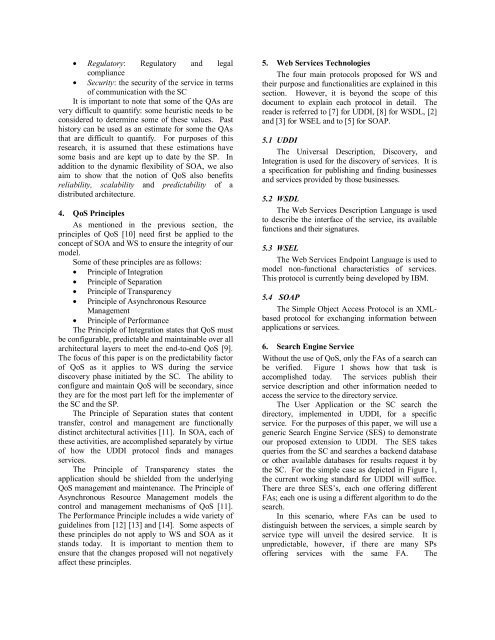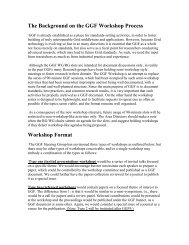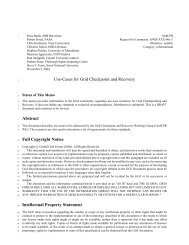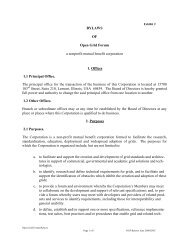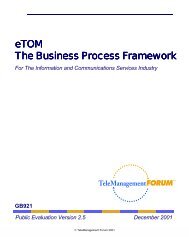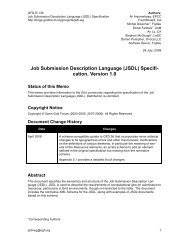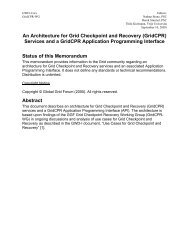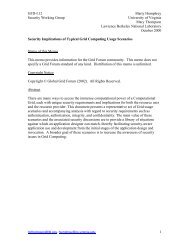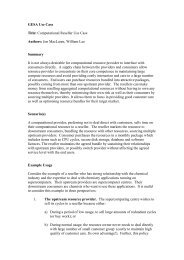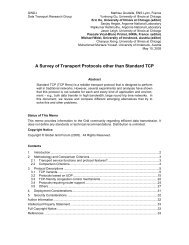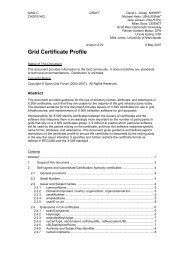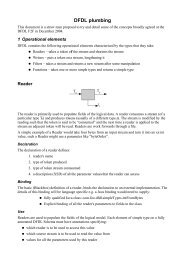Modeling the Aspects of Quality of Service in Web Services and ...
Modeling the Aspects of Quality of Service in Web Services and ...
Modeling the Aspects of Quality of Service in Web Services and ...
You also want an ePaper? Increase the reach of your titles
YUMPU automatically turns print PDFs into web optimized ePapers that Google loves.
• Regulatory: Regulatory <strong>and</strong> legal<br />
compliance<br />
• Security: <strong>the</strong> security <strong>of</strong> <strong>the</strong> service <strong>in</strong> terms<br />
<strong>of</strong> communication with <strong>the</strong> SC<br />
It is important to note that some <strong>of</strong> <strong>the</strong> QAs are<br />
very difficult to quantify: some heuristic needs to be<br />
considered to determ<strong>in</strong>e some <strong>of</strong> <strong>the</strong>se values. Past<br />
history can be used as an estimate for some <strong>the</strong> QAs<br />
that are difficult to quantify. For purposes <strong>of</strong> this<br />
research, it is assumed that <strong>the</strong>se estimations have<br />
some basis <strong>and</strong> are kept up to date by <strong>the</strong> SP. In<br />
addition to <strong>the</strong> dynamic flexibility <strong>of</strong> SOA, we also<br />
aim to show that <strong>the</strong> notion <strong>of</strong> QoS also benefits<br />
reliability, scalability <strong>and</strong> predictability <strong>of</strong> a<br />
distributed architecture.<br />
4. QoS Pr<strong>in</strong>ciples<br />
As mentioned <strong>in</strong> <strong>the</strong> previous section, <strong>the</strong><br />
pr<strong>in</strong>ciples <strong>of</strong> QoS [10] need first be applied to <strong>the</strong><br />
concept <strong>of</strong> SOA <strong>and</strong> WS to ensure <strong>the</strong> <strong>in</strong>tegrity <strong>of</strong> our<br />
model.<br />
Some <strong>of</strong> <strong>the</strong>se pr<strong>in</strong>ciples are as follows:<br />
• Pr<strong>in</strong>ciple <strong>of</strong> Integration<br />
• Pr<strong>in</strong>ciple <strong>of</strong> Separation<br />
• Pr<strong>in</strong>ciple <strong>of</strong> Transparency<br />
• Pr<strong>in</strong>ciple <strong>of</strong> Asynchronous Resource<br />
Management<br />
• Pr<strong>in</strong>ciple <strong>of</strong> Performance<br />
The Pr<strong>in</strong>ciple <strong>of</strong> Integration states that QoS must<br />
be configurable, predictable <strong>and</strong> ma<strong>in</strong>ta<strong>in</strong>able over all<br />
architectural layers to meet <strong>the</strong> end-to-end QoS [9].<br />
The focus <strong>of</strong> this paper is on <strong>the</strong> predictability factor<br />
<strong>of</strong> QoS as it applies to WS dur<strong>in</strong>g <strong>the</strong> service<br />
discovery phase <strong>in</strong>itiated by <strong>the</strong> SC. The ability to<br />
configure <strong>and</strong> ma<strong>in</strong>ta<strong>in</strong> QoS will be secondary, s<strong>in</strong>ce<br />
<strong>the</strong>y are for <strong>the</strong> most part left for <strong>the</strong> implementer <strong>of</strong><br />
<strong>the</strong> SC <strong>and</strong> <strong>the</strong> SP.<br />
The Pr<strong>in</strong>ciple <strong>of</strong> Separation states that content<br />
transfer, control <strong>and</strong> management are functionally<br />
dist<strong>in</strong>ct architectural activities [11]. In SOA, each <strong>of</strong><br />
<strong>the</strong>se activities, are accomplished separately by virtue<br />
<strong>of</strong> how <strong>the</strong> UDDI protocol f<strong>in</strong>ds <strong>and</strong> manages<br />
services.<br />
The Pr<strong>in</strong>ciple <strong>of</strong> Transparency states <strong>the</strong><br />
application should be shielded from <strong>the</strong> underly<strong>in</strong>g<br />
QoS management <strong>and</strong> ma<strong>in</strong>tenance. The Pr<strong>in</strong>ciple <strong>of</strong><br />
Asynchronous Resource Management models <strong>the</strong><br />
control <strong>and</strong> management mechanisms <strong>of</strong> QoS [11].<br />
The Performance Pr<strong>in</strong>ciple <strong>in</strong>cludes a wide variety <strong>of</strong><br />
guidel<strong>in</strong>es from [12] [13] <strong>and</strong> [14]. Some aspects <strong>of</strong><br />
<strong>the</strong>se pr<strong>in</strong>ciples do not apply to WS <strong>and</strong> SOA as it<br />
st<strong>and</strong>s today. It is important to mention <strong>the</strong>m to<br />
ensure that <strong>the</strong> changes proposed will not negatively<br />
affect <strong>the</strong>se pr<strong>in</strong>ciples.<br />
5. <strong>Web</strong> <strong>Service</strong>s Technologies<br />
The four ma<strong>in</strong> protocols proposed for WS <strong>and</strong><br />
<strong>the</strong>ir purpose <strong>and</strong> functionalities are expla<strong>in</strong>ed <strong>in</strong> this<br />
section. However, it is beyond <strong>the</strong> scope <strong>of</strong> this<br />
document to expla<strong>in</strong> each protocol <strong>in</strong> detail. The<br />
reader is referred to [7] for UDDI, [8] for WSDL, [2]<br />
<strong>and</strong> [3] for WSEL <strong>and</strong> to [5] for SOAP.<br />
5.1 UDDI<br />
The Universal Description, Discovery, <strong>and</strong><br />
Integration is used for <strong>the</strong> discovery <strong>of</strong> services. It is<br />
a specification for publish<strong>in</strong>g <strong>and</strong> f<strong>in</strong>d<strong>in</strong>g bus<strong>in</strong>esses<br />
<strong>and</strong> services provided by those bus<strong>in</strong>esses.<br />
5.2 WSDL<br />
The <strong>Web</strong> <strong>Service</strong>s Description Language is used<br />
to describe <strong>the</strong> <strong>in</strong>terface <strong>of</strong> <strong>the</strong> service, its available<br />
functions <strong>and</strong> <strong>the</strong>ir signatures.<br />
5.3 WSEL<br />
The <strong>Web</strong> <strong>Service</strong>s Endpo<strong>in</strong>t Language is used to<br />
model non-functional characteristics <strong>of</strong> services.<br />
This protocol is currently be<strong>in</strong>g developed by IBM.<br />
5.4 SOAP<br />
The Simple Object Access Protocol is an XMLbased<br />
protocol for exchang<strong>in</strong>g <strong>in</strong>formation between<br />
applications or services.<br />
6. Search Eng<strong>in</strong>e <strong>Service</strong><br />
Without <strong>the</strong> use <strong>of</strong> QoS, only <strong>the</strong> FAs <strong>of</strong> a search can<br />
be verified. Figure 1 shows how that task is<br />
accomplished today. The services publish <strong>the</strong>ir<br />
service description <strong>and</strong> o<strong>the</strong>r <strong>in</strong>formation needed to<br />
access <strong>the</strong> service to <strong>the</strong> directory service.<br />
The User Application or <strong>the</strong> SC search <strong>the</strong><br />
directory, implemented <strong>in</strong> UDDI, for a specific<br />
service. For <strong>the</strong> purposes <strong>of</strong> this paper, we will use a<br />
generic Search Eng<strong>in</strong>e <strong>Service</strong> (SES) to demonstrate<br />
our proposed extension to UDDI. The SES takes<br />
queries from <strong>the</strong> SC <strong>and</strong> searches a backend database<br />
or o<strong>the</strong>r available databases for results request it by<br />
<strong>the</strong> SC. For <strong>the</strong> simple case as depicted <strong>in</strong> Figure 1,<br />
<strong>the</strong> current work<strong>in</strong>g st<strong>and</strong>ard for UDDI will suffice.<br />
There are three SES’s, each one <strong>of</strong>fer<strong>in</strong>g different<br />
FAs; each one is us<strong>in</strong>g a different algorithm to do <strong>the</strong><br />
search.<br />
In this scenario, where FAs can be used to<br />
dist<strong>in</strong>guish between <strong>the</strong> services, a simple search by<br />
service type will unveil <strong>the</strong> desired service. It is<br />
unpredictable, however, if <strong>the</strong>re are many SPs<br />
<strong>of</strong>fer<strong>in</strong>g services with <strong>the</strong> same FA. The


